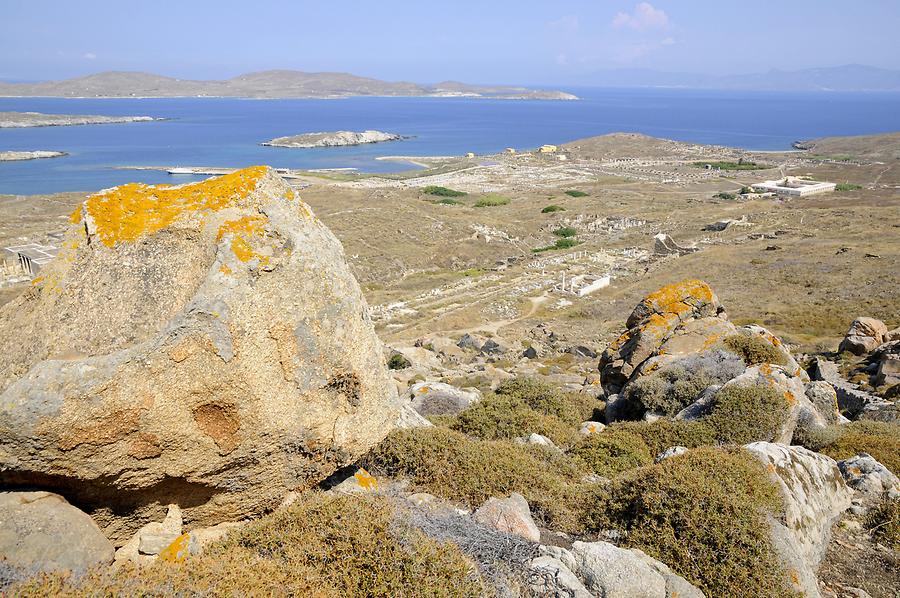The Archeological Site of Delos#

The Archeological Site of Delos, June 2010, © Gerhard Huber, under CC BY-NC 4.0 +Edu
Die winzige Insel Delos ist heute still, einsam und verlassen. Das war nicht immer so, denn vor zweieinhalbtausend Jahren schlug hier das sakrale Herz des antiken Griechenlands. Die Kykladen tragen ihren Namen, weil sie einen Kreis um das heilige Delos bilden, den Geburtsort der göttlichen Zwillinge Artemis und Apollon. Schon im 9. Jahrhundert vor unserer Zeitrechnung entstand hier das erste Heiligtum für Apollon, einen der zwölf Hauptgötter des griechischen Pantheons. In der Folgezeit zog die Kultstätte Pilger aus der gesamten antiken Welt an, die zahlreiche Weihegaben für den Gott der Künste und des Lichts hinterließen. Dieses bedeutende Heiligtum entstand wahrscheinlich gerade deshalb auf dem unbedeutenden Inselchen Delos, weil es zunächst keinem der vielen konkurrierenden Stadt- und Inselstaaten gehörte, quasi göttliches Niemandsland war. Anfangs versuchte der mächtige Stadtstaat von Naxos durch zahlreiche Weihegeschenke und Tempelbauten den Einfluss über Delos zu gewinnen. Nach den Perserkriegen jedoch übernahmen die Athener die Oberherrschaft. Um jede Konkurrenz auszuschließen, erließen sie das Dekret, dass auf Delos weder Kinder geboren noch Tote beigesetzt werden dürften. Zudem machten sie Delos zum Sitz des Delisch-Attischen Seebundes, eine militärische Allianz unabhängiger Stadtstaaten unter Vorsitz von Athen, die zum Ziel hatte, die gerade aus persischer Herrschaft befreiten Inseln zu schützen. Doch im Laufe der Zeit gewannen die Athener immer mehr politische und wirtschaftliche Macht und als sie dann noch die Seebundkasse von Delos nach Athen verlegten, war der Stern der heiligen Insel im Sinken begriffen. Das änderte sich aber, als die Römer im 2. vorchristlichen Jahrhundert kamen. Sie bauten Delos zum wichtigsten Handelszentrum der östlichen Ägäis aus. In kurzer Zeit entstand auf der nur 5 km langen und einen Kilometer breiten Insel eine antike Metropole mit 25.000 Einwohnern, deren Blüte jedoch kaum
80 Jahre währte. Dann setzten pontische und persische Plünderungen der blühenden Insel ein Ende. Fast alle Bewohner flüchteten und zurück blieb ein menschenleeres Delos, das langsam zur Ruinenstadt zerfiel. Seit 1872 arbeiten französische Archäologen an ihrer Freilegung.
Delos war in drei große Stadtviertel gegliedert: Ganz im Norden dehnte sich der heilige Bezirk mit zahlreichen Tempelanlagen aus, südlich davon bildeten mehrere Agoren das Herz des Marktviertels und hügelwärts schloss das Theaterviertel mit den luxuriösen Villen der Reichen an.
The tiny island of Delos is silent, lonely and abandoned today. That was not always the case, because two and a half thousand years ago the sacred heart of ancient Greece struck here. The Cyclades bear their name because they form a circle around the sacred Delos, the birthplace of the divine twins Artemis and Apollon. As early as the 9th century BC, the first sanctuary was built here for Apollo. He is one of the twelve main gods of the Greek pantheon. In the following years, the place of worship attracted pilgrims from all over the ancient world. They left numerous consecrations for the god of arts and light. This important sanctuary probably originated on the insignificant islet of Delos, because at first it did not belong to any of the many competing city and island states. It was almost a divine no-man's-land. At first, the powerful city-state of Naxos tried to gain influence over Delos through numerous consecration gifts and temples. After the Persian wars, however, the Athenians took over the supremacy. In order to exclude any competition, they issued a decree that on Delos neither children should be born nor dead should be buried. In addition, they made Delos the seat of the Delish-Attic Confederation. This was a military alliance of independent city-states chaired by Athens. It had the goal of protecting the islands newly liberated from Persian rule. But as time went on, the Athenians gained more and more political and economic power and when they moved the checkout of the Delish-Attic Confederation from Delos to Athens, the island was in decline. But that changed when the Romans arrived in the 2nd century BC. They made Delos the main trading center of the eastern Aegean. In a short time, an ancient metropolis with 25,000 inhabitants was built on the only 5 km long and one kilometer wide island. But the bloom hardly lasted 80 years. Then Pontic and Persian looting put an end to the blooming island. Almost all the inhabitants fled and left a deserted Delos, which slowly disintegrated into a ruined city. Since 1872 French archaeologists are working on its exposure.
Delos was divided into three major districts: to the north, the sacred precinct with its numerous temples, to the south of which several agorists formed the heart of the market district and, up the hill, the theater district with luxurious mansions of the rich.